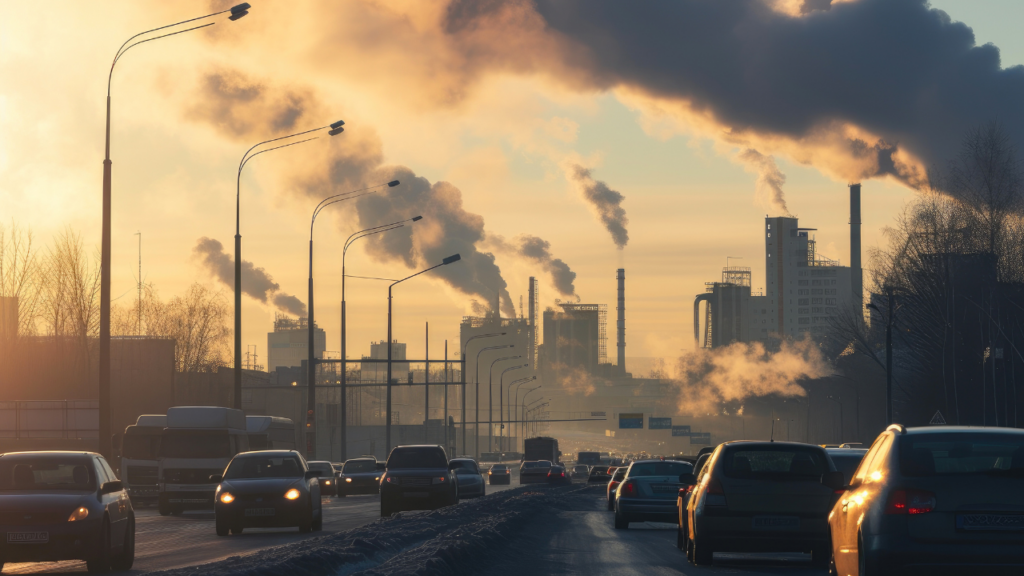As a species, we have reshaped the world to fit our ambitions, building cities that scrape the sky and digital networks that pulse with life. But in doing so, we’ve also filled the air with invisible threats. The atmosphere of opportunity that surrounds us is often tainted, laden with harmful substances silently infiltrating our lungs.
Urban air pollution is one of the defining challenges of our time. Complex in its origins, dynamic in its behavior, and increasingly beyond the reach of traditional tools. But as cities get smarter, a powerful new ally emerges in the fight for cleaner air: artificial intelligence (AI).
What if AI could help us see the invisible? What if it could help us breathe easier, live longer, and reduce the adverse health effects of exposure to unseen toxic substances? AI offers a radically new toolkit for tackling this problem. Also, enabling us to analyze vast datasets, uncover hidden patterns, predict future conditions, and optimize the functioning of our cities.
AI-Powered Monitoring: A Granular View of Pollution
Traditional air quality monitoring relies on a limited number of stationary sensors, providing a snapshot rather than a comprehensive picture. AI, combined with dense networks of low-cost sensors and mobile monitoring platforms, offers a far more granular and real-time understanding of pollution levels.
By deploying sensors on buses, taxis, and even drones, we can gather hyperlocal data, mapping pollution hotspots with unprecedented precision. AI algorithms can then fuse data from various sources, including weather information and traffic patterns, to create dynamic pollution maps that reflect real-world conditions.
Predictive Modeling: Forecasting Air Quality
AI’s predictive capabilities are transformative. By analyzing historical pollution data, weather patterns, traffic flow, industrial activity, and other factors, AI algorithms can forecast pollution levels with increasing accuracy.
This allows cities to anticipate pollution spikes, issue timely public health advisories, and implement preemptive measures to mitigate their impact. For example, some cities are using AI to predict ozone levels, allowing them to activate smog alerts and encourage residents to limit outdoor activities.

Understanding the Enemy: How AI is Revolutionizing Air Quality Monitoring
Billions of people worldwide breathe air exceeding World Health Organization (WHO) limits for pollutants like particulate matter (PM2.5) and nitrogen dioxide (NO2), leading to over 8 million premature deaths annually and costing the global economy $8 trillion each year.
Historically, our understanding of air pollution relied on sparse, expensive stationary monitoring stations. While providing valuable data on chemical composition and particle size, these offer limited insight into hyperlocal exposure – the variations individuals experience moving through cities. Today, that’s changing thanks to artificial intelligence, modeling, and sensor networks.
Smarter Measurements, Smarter Cities
Early applications of machine learning in air quality control focused on models like random forests, gradient boosting, and hybrid approaches. These enable researchers to better predict pollution concentrations and disentangle the effects of variables like weather, offering new insights into the effectiveness of policy interventions.
More recently, machine learning has been used to improve the quality of measurements from air quality sensors and determine complex pollution sources by analyzing datasets integrating pollution levels, meteorological conditions, traffic flows, industrial operations, and more. Combined with sensors, satellite imagery, and even crowdsourced data, AI can generate high-resolution, near real-time pollution maps to track exposure and inform public health measures.
One example is DyNA system, developed at Imperial College London, which combines physical modeling with AI techniques. It utilizes a custom recurrent neural network to process time-series data and forecast pollution events. When combined with data assimilation techniques, DyNA can incorporate real-world observations to improve the accuracy and speed of air quality predictions. Google’s Air Quality API also combines various sources to estimate global pollutant concentrations.
Beyond Predictions: AI-Driven Solutions for Cleaner Air
The impact of AI extends beyond monitoring and prediction. Here’s how AI is actively contributing to cleaner air:
Targeted Interventions: By identifying pollution hotspots and their sources, AI allows for targeted interventions, focusing resources where they are most needed.
Optimized Traffic Management: AI can optimize traffic flow to reduce congestion and associated emissions, improving air quality in urban areas.
Industrial Emissions Control: AI algorithms can analyze industrial processes and emissions data to identify inefficiencies and recommend optimization strategies for reducing pollution.
Smart Urban Planning: AI can inform urban planning decisions, guiding the development of green spaces, promoting sustainable transportation options, and optimizing building design for improved ventilation and reduced pollution impact.
Personalized Exposure Alerts: AI-powered apps can provide individuals with real-time, location-specific pollution alerts, empowering them to make informed decisions about their activities and minimize exposure.

Empowering Citizens and Urban Planners: AI for a Breathable Future
Smarter systems empower smarter decisions, not just for cities but for citizens too. Imagine a runner or cyclist receiving real-time alerts on their smartwatch, pinpointing pollution hotspots along their route, and recommending slowing down or switching to the less polluted side of a narrow street. This previously invisible information is now within reach.
AirTrack, developed by Air Aware Labs, has already empowered athletes and commuters to reroute their journeys based on real-time exposure data. This system combines GPS data, AI, air pollution models, and user behavior to provide personalized air pollution exposure information, enabling smarter decisions – from altering a cycling route to adjusting a running schedule or simply choosing the best time to step outside.
Over time, AI will guide entire urban systems – transportation, energy, land use – towards a smarter, cleaner equilibrium. This includes dynamic road pricing, on-demand mobility, and electric autonomous vehicles that adjust to air quality targets.
By modeling the impact of buildings on airflow, emissions, and pedestrian movement, AI tools help avoid creating pollution hotspots and prioritize health in design, from initial blueprint to final build. This shifts planning from reactive to proactive, enabling healthier cities by design.
Ethical, Equitable, and Locally Validated AI
AI’s potential is immense, but so are the risks if implemented irresponsibly. Air pollution disproportionately affects the poorest, and AI could exacerbate these inequities. For example, due to lack of infrastructure, Google’s API has no coverage in many African cities.
For AI to be a force for good, it must be:
Inclusive: Benefits must be accessible to all, not just those with smartphones or wearables.
Equitable: Systems must be designed to prevent shifting pollution burdens onto already overburdened communities.
Transparent and Ethical: Clear governance, open access, and meaningful community engagement are essential for building public trust.
AI should not be imposed upon people but built with them. This means opening access to data, supporting open-source development, and involving local voices in the design and implementation of tools. Simultaneously, AI is essential if we are to achieve global targets like the WHO’s goal of reducing the health impacts of air pollution by 50% by 2040, set at the World Conference on Air Pollution and Health.
Breathing Easier: AI-Powered Urban Sustainability and the Future of Clean Air
Artificial intelligence (AI) is revolutionizing the fight against urban air pollution, transforming how we measure, predict, optimize, and act. It offers the tools to build smarter, cleaner, more equitable, and ultimately more livable cities. This progress aligns perfectly with initiatives like the World Economic Forum’s Clean Air Alliance and C40’s focus on air quality co-benefits through climate action.
Beyond Algorithms: Collaborative Action for Clean Air
However, realizing this potential requires more than just sophisticated algorithms. It demands intentional collaboration between governments, researchers, startups, municipal leaders, and, crucially, the people who breathe the air every day.
Philanthropic institutions, multilateral organizations, and the private sector must work together to close data gaps in underrepresented regions. Clean air should not be a privilege determined by postcode or GDP. Investing in robust data collection and monitoring infrastructure, especially in developing nations, is crucial for ensuring equitable access to clean air solutions.
Empowering Communities, Driving Change
The power of AI lies in its ability to empower communities. By providing accessible, real-time air quality information, AI tools enable individuals to make informed decisions about their health and well-being. This personalized approach fosters a sense of ownership and encourages active participation in creating healthier environments.
Furthermore, AI-driven solutions can facilitate citizen science initiatives, allowing individuals to contribute to data collection and monitoring efforts. This collaborative approach not only strengthens data resources but also fosters a sense of shared responsibility for air quality.
From Data to Action: Building Smart, Breathable Cities
AI is not simply about gathering data; it’s about translating that data into meaningful action. AI-powered platforms can inform urban planning decisions, optimize transportation systems, and improve industrial emissions control, leading to tangible improvements in air quality.
By integrating AI into smart city initiatives, we can create dynamic urban environments that respond to changing conditions and prioritize the health and well-being of their citizens. Imagine a city where traffic flow adjusts automatically to minimize congestion and emissions, where buildings are designed to optimize ventilation and reduce pollution, and where individuals receive personalized alerts about air quality risks.
A Future of Clean Air: Equity as Our Compass
Our air should not be a hidden hazard. With AI as our ally and equity as our compass, we can build smart cities where clean air flows as freely as the data that powers them. This requires a commitment to transparency, open data sharing, and meaningful community engagement.
By working together, we can leverage the transformative power of AI to create a future where everyone can breathe easier.

